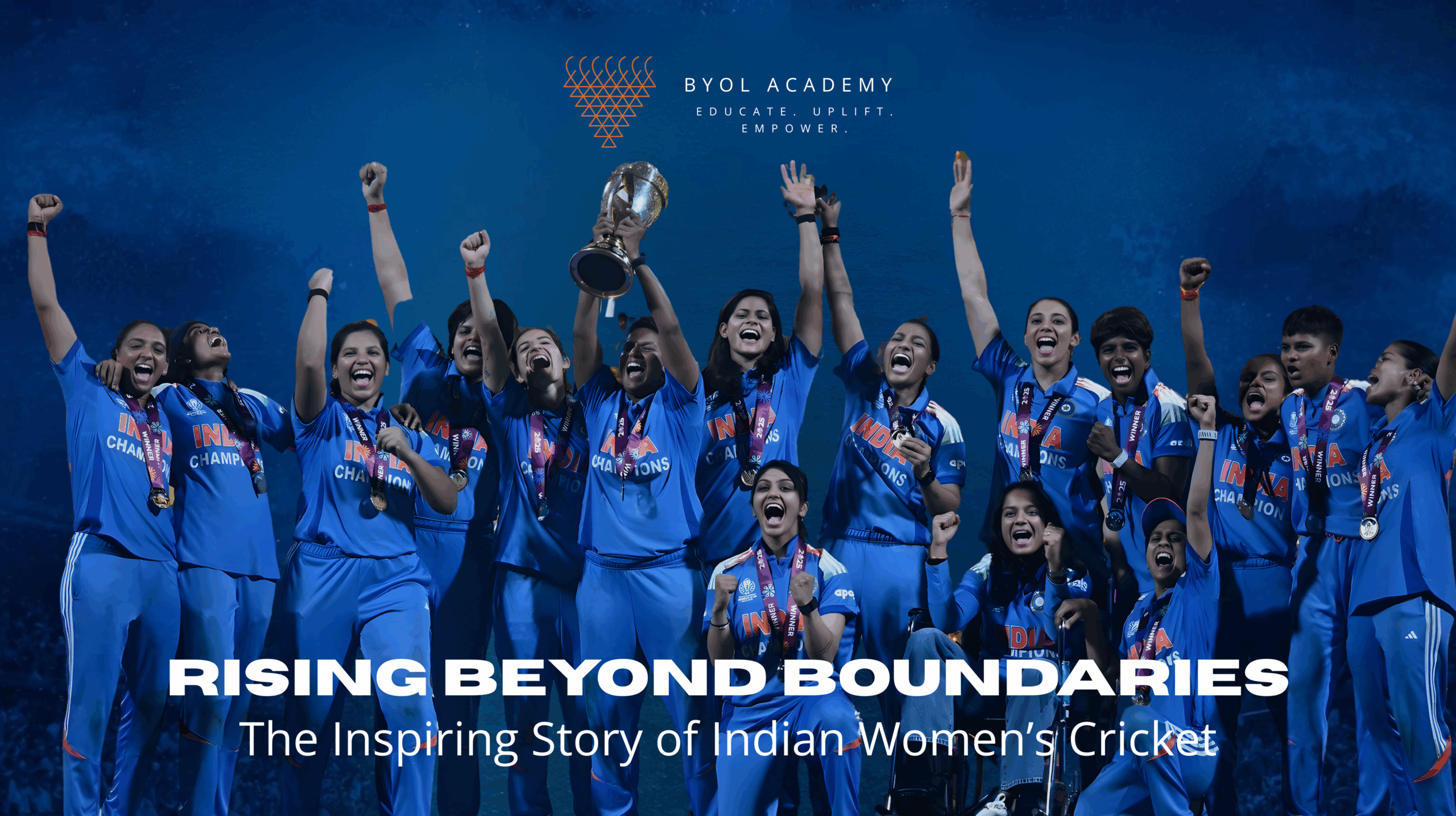Drinking in the past was social and ritualized, with less potent brews We raise our glasses to celebrate, to cope, […]
Rising Beyond Boundaries- The Inspiring Story of Indian Women’s Cricket

For a long time, cricket has been seen as a religion in India. But for decades, this devotion was mostly for the men in blue. Behind the glitz of full stadiums and loud crowds was another team, a group of women who played not for fame but for the love of the game. The story of the India Women’s National Cricket Team, also known as the Women in Blue, is more than just a series of matches and medals. It is a story of strength, quiet revolutions, and an unending fight for equality in sports.
The Early Days: Battling Silence and Stereotypes
The Women’s Cricket Association of India (WCAI) was formed in 1973, which was the start of women’s cricket in India. People often raised their eyebrows and smiled condescendingly when women stepped onto a cricket field. There weren’t any sponsors, contracts, or even a lot of recognition. The players trained with borrowed gear and paid for their own travel while also doing chores, going to school, and working full-time.
The first game was in 1976 in Bangalore against the West Indies. This was a historic moment that marked India’s entry into international women’s cricket, even though the game ended in a tie, it started a small fire that would grow into a huge one in the years to come. Shantha Rangaswamy led India to its first Test win ever in 1978 against the West Indies in Patna. It wasn’t just a win on the score board, it was a win for all the women who dared to dream.
Struggles Behind the Stumps
For many years, women’s cricket survived in the shadows of indifference. The players lacked basic facilities and played in front of empty stands. Yet they persisted, names like Diana Edulji, Sandhya Agarwal, and Shubhangi Kulkarni became synonymous with determination and grace. They played purely for passion, often without match fees or financial support. The turning point came when the BCCI (Board of Control for Cricket in India) took over women’s cricket in 2006. The merger with the WCAI not only brought better administration and visibility but also opened the gates to sponsorship, infrastructure, and professional coaching. For the first time, Indian women cricketers began to receive the institutional support they long deserved.
From Shadows to Spotlight: The Mithali Raj and Jhulan Goswami Legacy
If women’s cricket in India has a golden chapter, it is written in the names of Mithali Raj and Jhulan Goswami. Mithali, often called the “Lady Sachin Tendulkar,” became the highest run-scorer in women’s ODI history, while Jhulan, with her relentless pace and discipline, remains one of the greatest fast bowlers the women’s game has ever seen. Their leadership transformed Indian women’s cricket from an underdog unit into a team capable of challenging giants. The 2005 World Cup in South Africa saw India reach the final for the first time, a feat that placed them firmly on the world map of cricket. Though they lost to Australia, the message was clear, “India’s women had arrived”.
The New Generation: Aggression, Flair, and Confidence
With the arrival of players like Harmanpreet Kaur, Smriti Mandhana, Shafali Verma, and Deepti Sharma, Indian women’s cricket entered a new era, one defined by fearless stroke play and aggressive intent. Harmanpreet’s explosive 171* against Australia in the 2017 World Cup semi-final remains one of the most iconic innings in cricket history, female.
The 2017 final against England, though heart breaking close, transformed the sport’s popularity in India. Millions watched as India fell just nine runs short of victory, and for the first time, the country stood still not for Virat Kohli, but for Harmanpreet and Mithali. The players became household names, inspiring a new generation of girls to pick up the bat.
Modern Triumphs: From Silver to Gold
The years that followed cemented India’s reputation as a powerhouse in women’s cricket. The team won gold at the 2022 Asian Games and silver at the 2022 Commonwealth Games, proving their dominance in multi-sport areas. Under Harmanpreet Kaur’s captaincy, India clinched their first-ever Women’s 50-over World Cup title in 2025, defeating South Africa by 52 runs, a defining moment that symbolized the culmination of five decades of persistence. India’s spin brigade, led by Deepti Sharma, Radha Yadav, and Sneh Rana, became a global force, while batters like Smriti Mandhana and Jemimah Rodrigues redefined elegance and innovation. In T20s, the team continued to impress, securing historic series wins, including their first-ever T20I series victory against England in 2025.
Equality and Recognition: A New Dawn
The BCCI’s 2022 decision to introduce equal match fees for men and women cricketers was a landmark move, signalling institutional respect and financial equality. Today, every woman representing India earns ₹15 lakh for a Test match, ₹6 lakh for an ODI, and ₹3 lakh for a T20I – the same as their male counterparts. This policy not only rectified decades of disparity but also encouraged young girls to pursue cricket as a viable career. With the introduction of the Women’s Premier League (WPL), India created a platform for talent, opportunity, and financial independence, much like the IPL did for men’s cricket years earlier.
The Spirit Beyond Statistics
Behind every run scored and wicket taken lies a story of courage of women who faced societal barriers, inadequate facilities, and the pressure of proving themselves in a male-dominated arena. Their journey is not merely about cricket, it’s about the empowerment of women through sport. Each name from Shantha Rangaswamy to Mithali Raj, from Jhulan Goswami to Smriti Mandhana, represents a chapter in India’s story of resilience. Today’s “Women in Blue” are not just athletes, they are symbols of change, breaking stereotypes and setting examples for generations to come.
India Women Triumph: Historic Victory in the 2025 ICC Women’s World Cup
Champions of the 2025 ICC Women’s World Cup In a thrilling finale at Mumbai’s Wankhede Stadium, India Women’s Cricket Team lifted their maiden ICC Women’s 50-over World Cup 2025, defeating South Africa by 52 runs. Batting first, India posted a commanding 312/6, powered by Smriti Mandhana’s elegant 117 and Harmanpreet Kaur’s fiery 63. The bowlers sealed the victory with clinical precision, Deepti Sharma’s 3/42 and Renuka Singh’s early breakthroughs dismantled South Africa’s chase. The electric atmosphere, filled with chants of “India! India!”, marked a defining moment for women’s cricket. With this triumph, the Women in Blue not only claimed the world title but also cemented their place as a global cricketing powerhouse and a symbol of national pride.
Conclusion: The Legacy of the Women in Blue
The Indian Women’s Cricket Team’s journey is one of passion meeting perseverance. From playing on dusty grounds without kits to lifting the World Cup in 2025, their rise has been nothing short of extraordinary. They have rewritten history, not just with records, but with resolve, proving that talent knows no gender. As they prepare for future challenges like the 2026 ICC Women’s T20 World Cup in England, one thing is certain the story of Indian women’s cricket is still being written, and it is a story the world is watching, learning from, and celebrating
References:
- ESPNcricinfo. India Women’s Cricket Records and Stats.
- ICC Official Website. Team Rankings and Player Profiles.
- BCCI Official Announcements, 2022–2025.
- Sportstar and InsideSport. Indian Women’s Cricket Coaching and Selection Updates.


